Friday night sees a clash of two of Europe’s elite with Barcelona taking on Bayern Munich in a one-legged UEFA Champions League tie. The clubs appear to be in vastly different cycles at the moment, with Bayern Munich very much on the up since appointing Hansi Flick in November, with the Bavarians going on to win the domestic double convincingly. Barcelona’s change in management this season hasn’t yielded the same success, with the Champions League now their last chance at a trophy this season, with questions marks over Quique Setién’s future already appearing. The identity and style of play implemented by the two coaches make for an interesting tactical battle, with Barcelona likely to have to adapt their usual tactics if they want to challenge Bayern.
This tactical analysis will analyse how both systems of play are likely to interact with one another, with analysis of previous games throughout the season being used to assess how both teams will likely respond to the tactical problems that will be presented.
Bayern’s build-up
The main tactical aspect that I believe dictates this game is Bayern Munich‘s build-up and their positional play, as this will dictate how Barcelona setup out of possession and also in possession.
We can see their most basic kind of structure below against Leverkusen in a 4-2-3-1/4-2-4. The two central midfielders will remain in central areas and occupy the opposition central midfielders, while the full-backs will push high and wide. The central positioning of the central midfielders, combined with the width from the full-backs, allows the wingers to occupy the half-space. In addition to this Thomas Müller acts a roaming number ten, and so he operates between the lines and will often move into the half-space also, allowing Bayern to create overloads. Bayern are lethal around the half-space, and their combination of spacing, timed movements, and technical ability allow them to progress the ball through this area often.
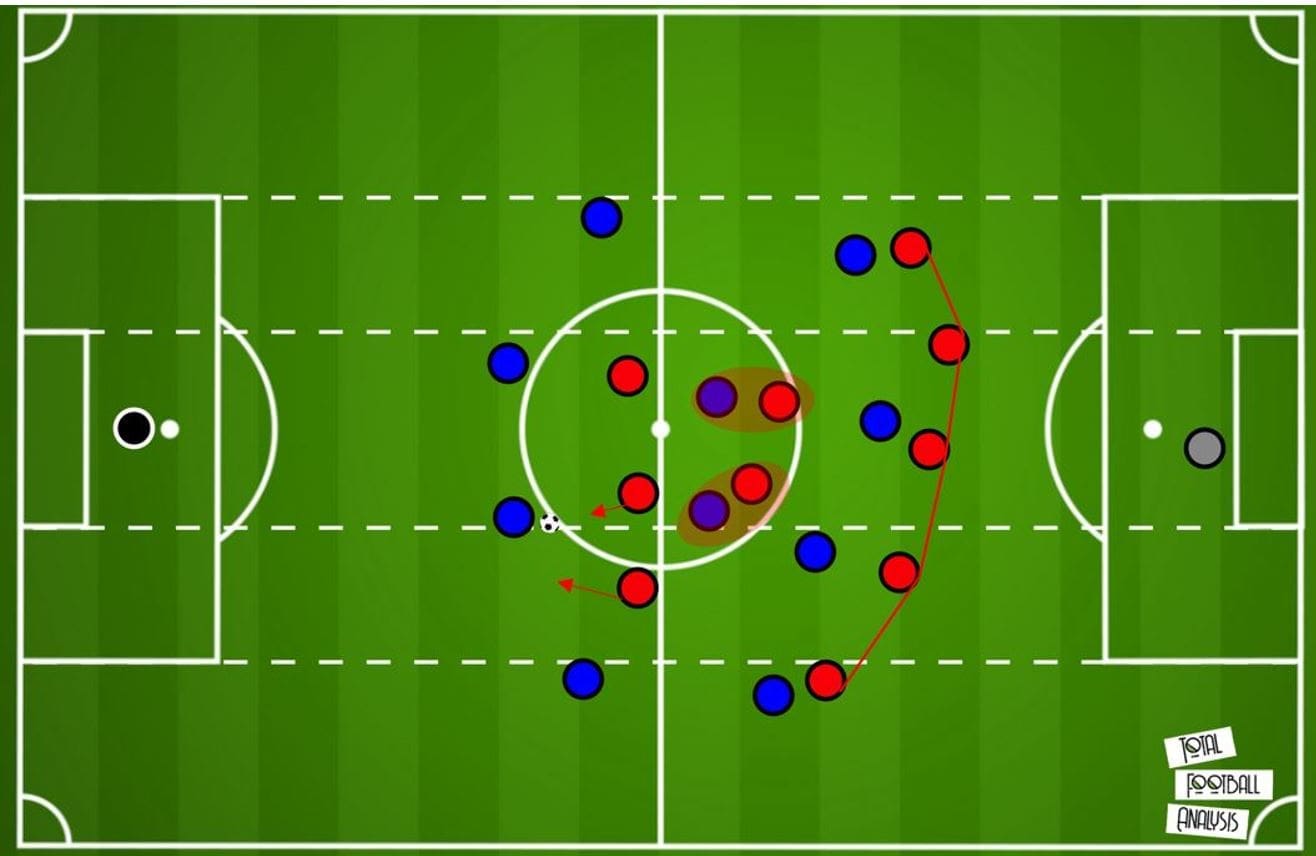
One of the advantages of playing this double pivot is the access it gives to the half-space and central areas, as with outside to in possessions, there is usually always one of the pivots available to receive the ball, which is not always the case with a single pivot. We can see in this theoretical situation, the ball is switched across to the left full-back.

Due to having two deeper midfielders, they have increased coverage of the pitch, and so the left sided pivot can move across easily to receive the ball. The effect this has on their positional play is that they can often engage the opposition’s midfielders from the front. When this is combined with the movements of the winger and of Müller, an overload can be created on the central midfielder, as they have to cover both players in front and behind. We can see one example of an intelligent movement which may be made, with the winger looking to supply more width and pin the opposition full-back, while Raumdeuter Müller can move into the half-space. A singular pivot would struggle to show for passes from the full-back so often, and so this method of ball progression would not be as accessible.
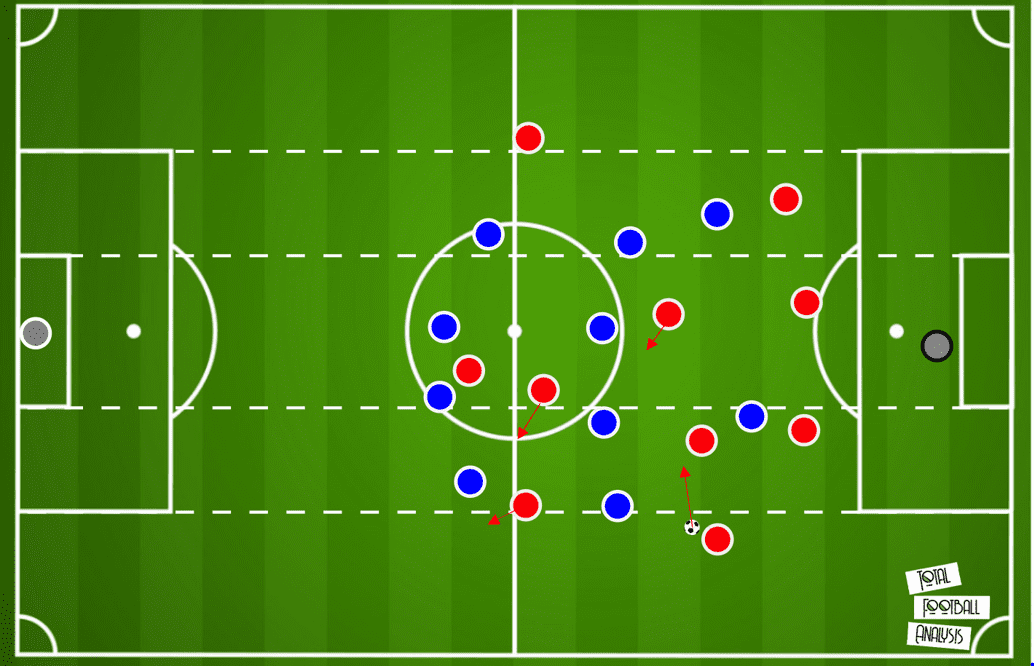
Bayern’s movement around the half-space is excellent and is seemingly only getting better, with all of this underpinned by the concepts of height, depth, width and occupation of the half-space (+ one). We can see an example here where depth is provided by Goretzka, who drops as a wide centre back in the half-space. Width is provided by the high full-back, and the winger occupies the half-space. Müller uses some excellent dynamic space occupation to arrive into the half-space facing forwards, meaning he can then access the height of the team (Lewandowski) who will make runs in behind. In terms of positional play, I think it is fair to label Bayern as certainly within the top two in the world.
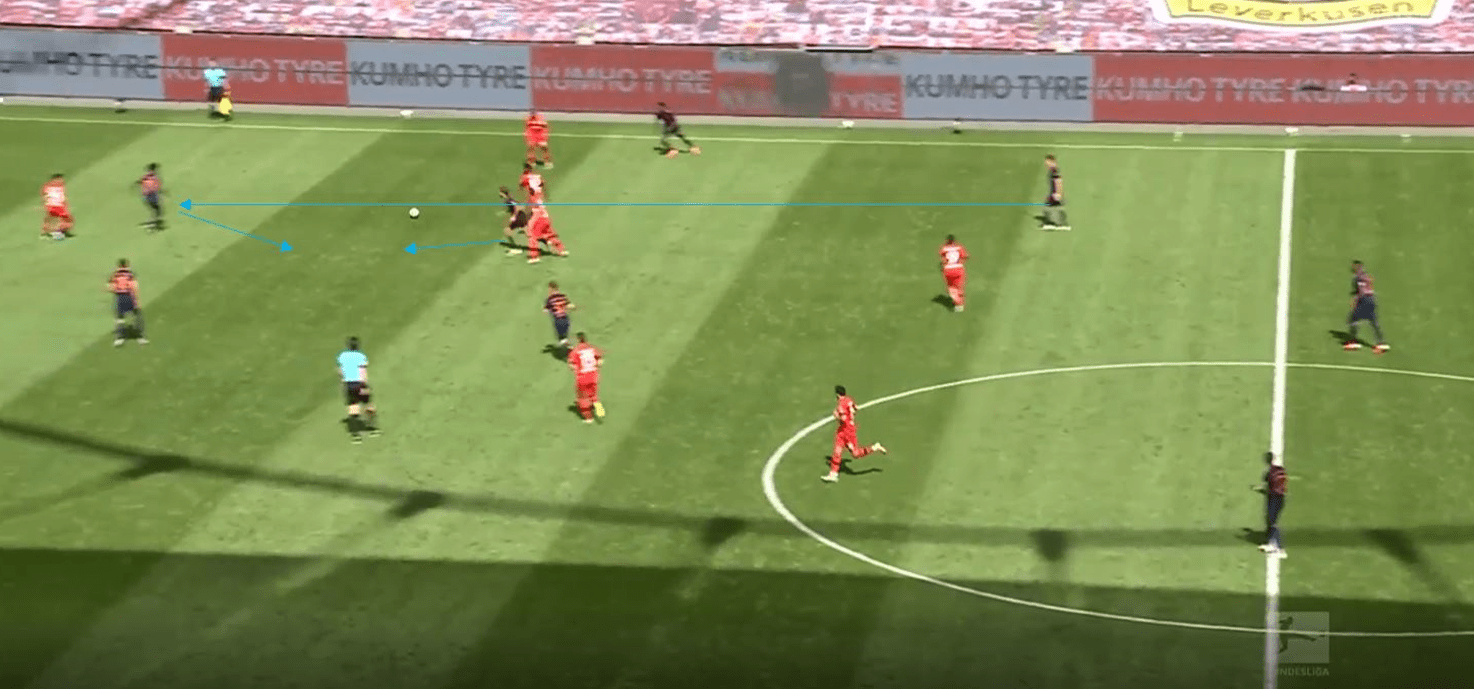
The central midfielders offer the most flexibility in terms of build-up, and it is their positioning which helps Bayern to progress the ball. One central midfielder will often drop into the back three to facilitate build-up, as if they drop into the centre of the back three as they do here, it allows the centre backs to move wider. This stretches the first line of the press, which in turn engages the second line of the press, which here forces Schalke to move from a 4-4-2 to a 4-3-3. The additional width of the back three also allows for the full-backs to push higher and wider, which then increases access to the half-space.

Central midfielders will also drop in as a wide centre back in the deep half-space, which has the same effect in allowing the full-back to push higher. Here Thomas Müller starts from a deeper position just behind Chelsea’s midfield, before then timing his run to arrive into space with good body orientation. Lewandowski will usually maintain the height in the side, and so will stay on the last defender to pin the defence back.

In deeper areas, they will also use the depth of the pitch to their advantage, and will drop central midfielders deeper as a single pivot to create pressing problems for the opposition. This is done often to escape man-oriented presses within the midfield, as the deeper the central midfielder gets, the less inclined the marker is to press. We can see here the pivot drops just in front of the Bayern back four to bypass the first line of pressure. The midfielder does not want to follow that high as they risk losing vertical compactness, and so the pivot is allowed time on the ball and can progress play.

We can see an example of this in game against Bayer Leverkusen, with Joshua Kimmich dropped deeper to escape the press of Charles Aránguiz, who won’t press that high to avoid conceding so much space behind him.

We can see those two concepts combined below, with a back three implemented and a single central pivot used. The back three allows usually for better access to the half-space, and so the opposition central midfielder becomes more engaged by the pass behind him. As a result, the central pivot is allowed more space and becomes a lower priority for the presser.

More detail on Bayern can also be found in this analysis I wrote just a few weeks ago on training a side to play against Bayern.
How can Barcelona press Bayern?
In my recent article detailing how to play against Bayern Munich, I suggested that a 4-1-4-1 makes the most sense logically to match up against Bayern defensively. In terms of this game, I don’t believe it is possible for Barcelona to line up in a 4-1-4-1 and still function well offensively, as a 4-1-4-1 doesn’t leave room for both Lionel Messi and Luis Suárez. As a result, I feel a 4-4-2 acts as the best way to allow both players in the team while allowing defensive stability.
The pressing abilities (or lack of) the front two possess mean that a high, intense press is unlikely, and so the pressing system should build this in. Nevertheless, against a team of Bayern’s quality, Barcelona can’t have passengers out of possession, and so the strikers here are given the role of cutting access to the Bayern Munich pivots. The wingers then press the full-backs, while the Barcelona central midfielders work with the Barcelona strikers to cut Bayern’s central build-up through the central midfielders or the Raumdeuter. Some pressure should still be applied on the ball to cut angles directly through the central areas.
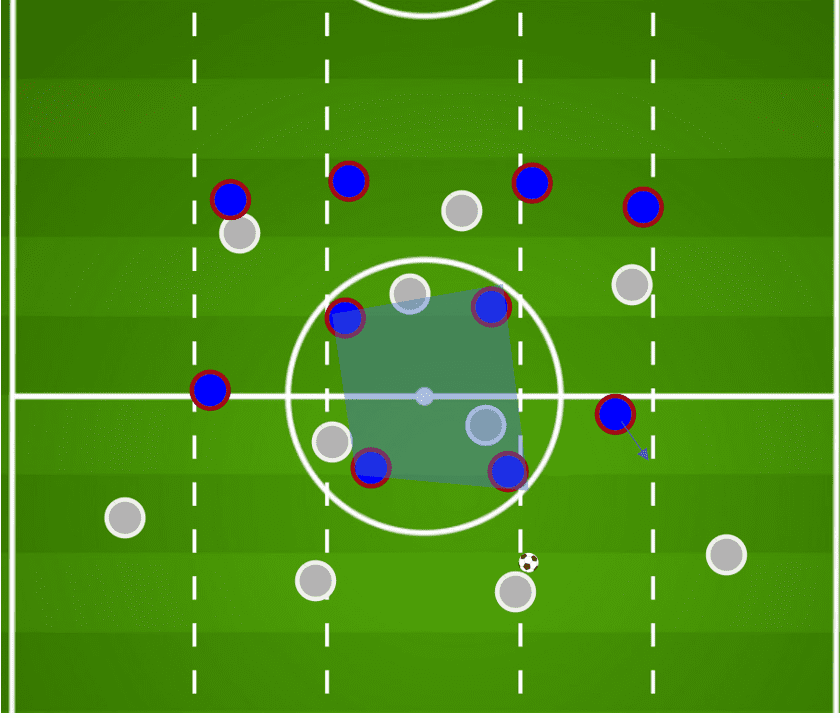
If the ball enters a wide area, the strikers should shuffle across and continue to disrupt the ability of the pivot to receive the ball. The wingers continue to press while protecting the inside lane, while the ball near central midfielder can drop to cover the Raumdeuter, rather than having to engage in duels in front of him.
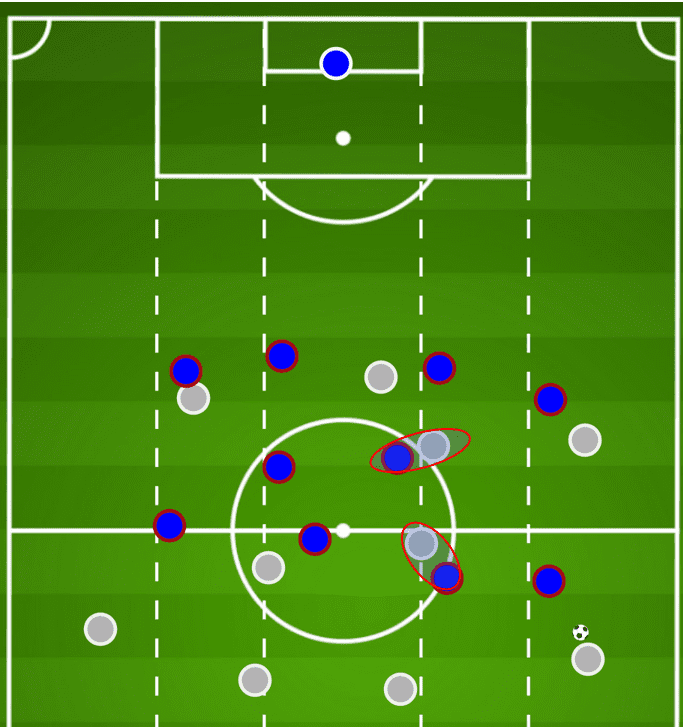
From this situation above we can see a pressing trap emerge in the example below. With access cut, the full-back goes to recycle possession to the centre back. This triggers the far striker to sprint and make an arced run to remove the left side of the pitch. The near striker can push forward slightly if needed, and protects the half-space while pressure is applied to the ball. With the centre now more open, the Barcelona central midfielders can push in and smother this area should a Bayern pivot move into this area to receive. Again, whether or not Barcelona have the players to execute such a trap is questionable.
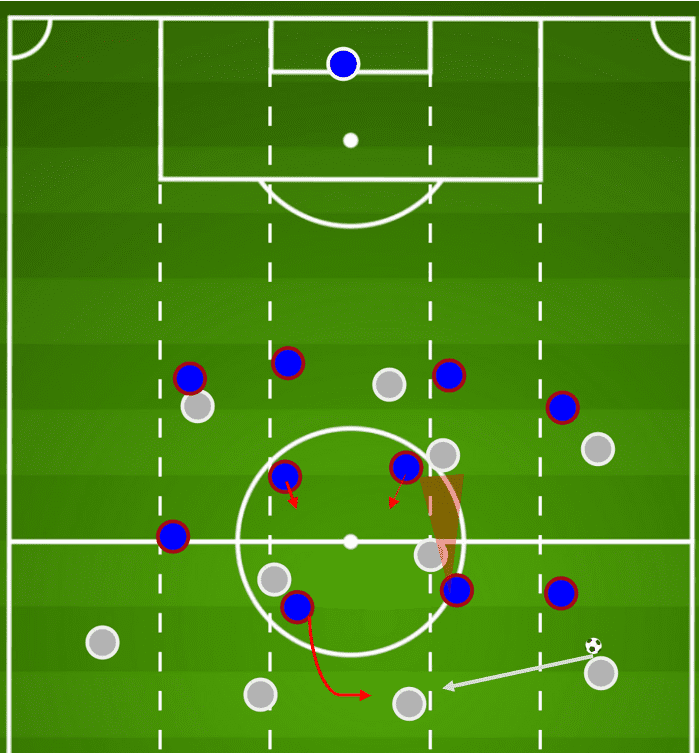
Bayern will then likely resort to using a back three often in possession, which will act as a trigger for Barcelona to move into more of a 4-3-3 at times. The wingers will now press the wide centre backs and cut the lane to the full-back, while the central midfielders will have to work hard to cover the half-space. One central striker presses the backline and covers lanes, while the other drops deeper and covers the single pivot. The far winger stays deeper initially but will move into position to press the other wide centre back if needed. If play is switched quickly, the half-space may be shut off to prevent direct ball progression at first.
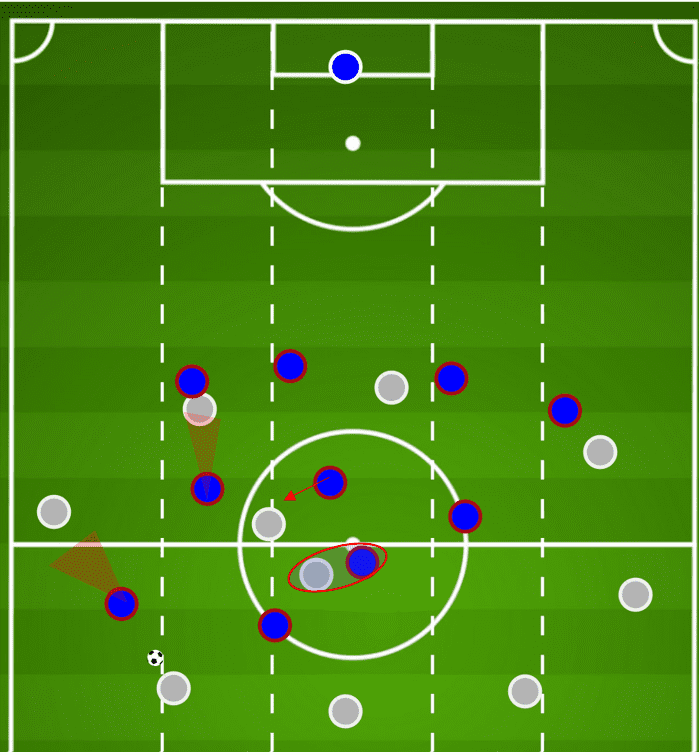
Barcelona’s pressing will have a massive impact on the game, and playing against a top-level side with passengers out of possession will not end well, and so they have to find a way to create an effective pressing system that accommodates their players. Whether or not this is possible against Bayern is another question. The fundamental issue with Bayern Munich is that they can play through, around or over you if they are at their best.
Barcelona’s build-up against Bayern’s press
As I’ve alluded to in the previous section, I don’t believe Barcelona will be able to adopt their usual system of a 4-3-1-2 or a rather relaxed 4-3-3 when pressing, and because of this, it is unlikely that their build-up shape will be able to remain the same. With a 4-4-2 seeming a likely option defensively, Barcelona may also go with a 4-4-2 in possession, which could also transition into a 4-3-3, which is not uncommon in Barcelona’s style this season. But before we talk about which system will best exploit Bayern, we need to understand Bayern’s pressing scheme.
Bayern press
The base structure of Bayern’s press is a 4-2-3-1, however it most commonly moves up into a 4-4-2 due to Müller pressing the centre backs with Lewandowski. We can see the basic structure of the press below, with the central midfielders pressing opposition central midfielders, two strikers pressing the centre backs, and the wingers pressing the full-backs while showing the outside lane to the wing.
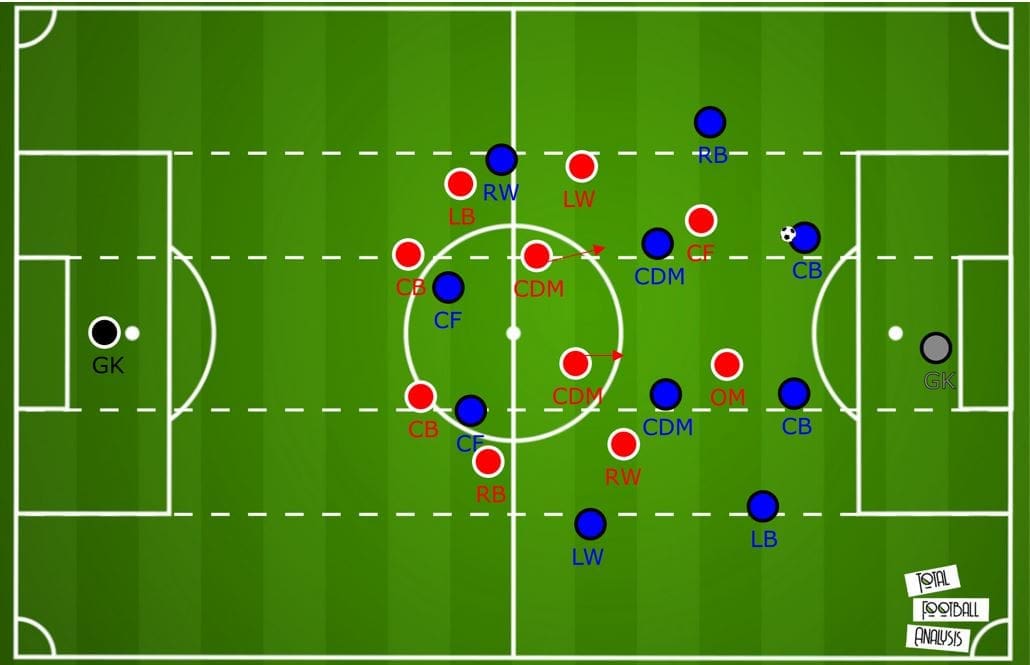
The relationship between the ten and the two eights means Bayern have some flexibility in their pressing, which we can see below. Here against a back three, Bayern’s winger jumps to press a wide centre back while cutting the lane wide. Müller then drops out of the first line and occupies the ball near Leverkusen pivot. Because of this, the central midfielder does not have to push higher, and so Bayern can remain in a 4-1-4-1 shape with increased cover in front of the defence.
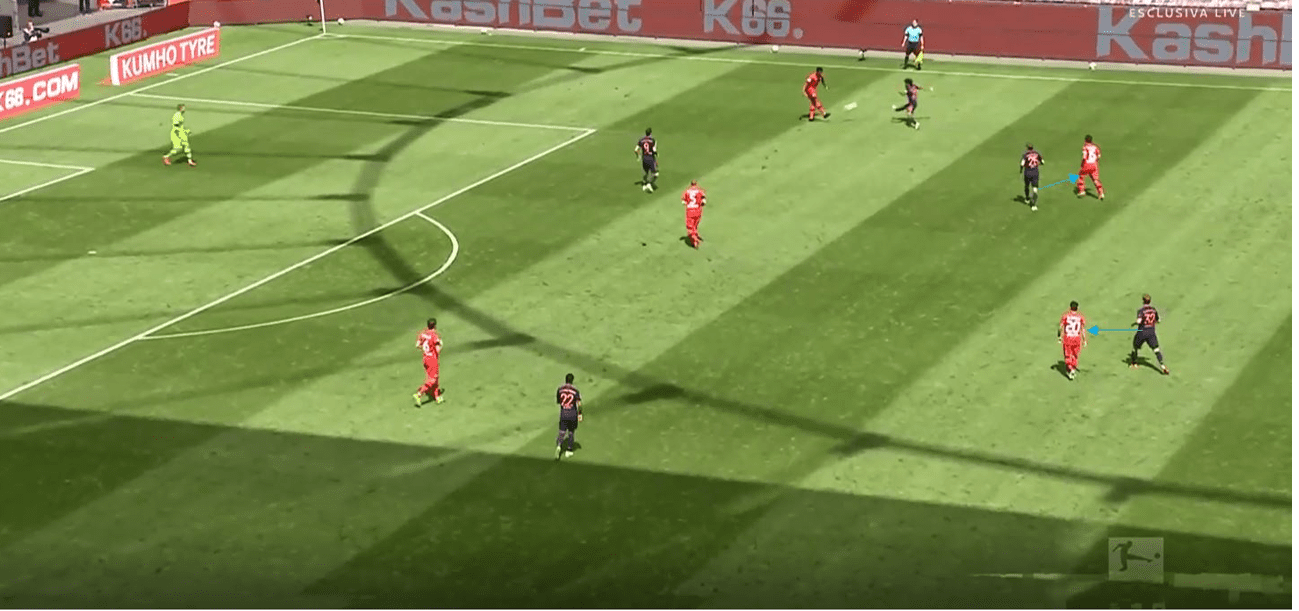
We can see in this example against a back four, Bayern jump into more of a 4-1-3-2, with Müller jumping to press the centre backs as he usually would against a back four. This time though he is able to kind of keep the pivot in his cover shadow, and so the other central midfielder does not need to commit that high. Gnabry is able to balance between the wing and centre, and so is in a position to press either should they get the ball. The opposition give the ball away here, and Bayern go onto score shortly after.
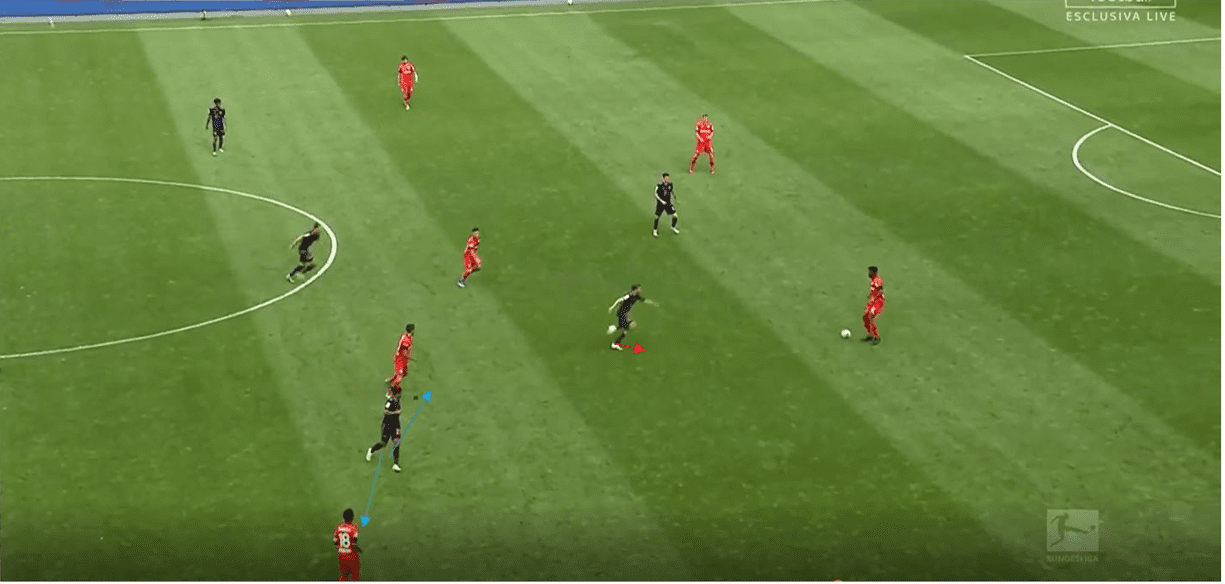
Against Chelsea in the second leg though, Bayern pressed in much more of a 4-2-3-1, with Müller more man orientated to the pivot rather than pressing the centre backs. It will be interesting to see how Müller behaves against Barcelona, and it will probably depend on the behaviour of Barcelona too. We can see the German presses the Chelsea pivot here, while Gnabry has sneaked slightly higher in anticipation of the centre back receiving the previous pass.
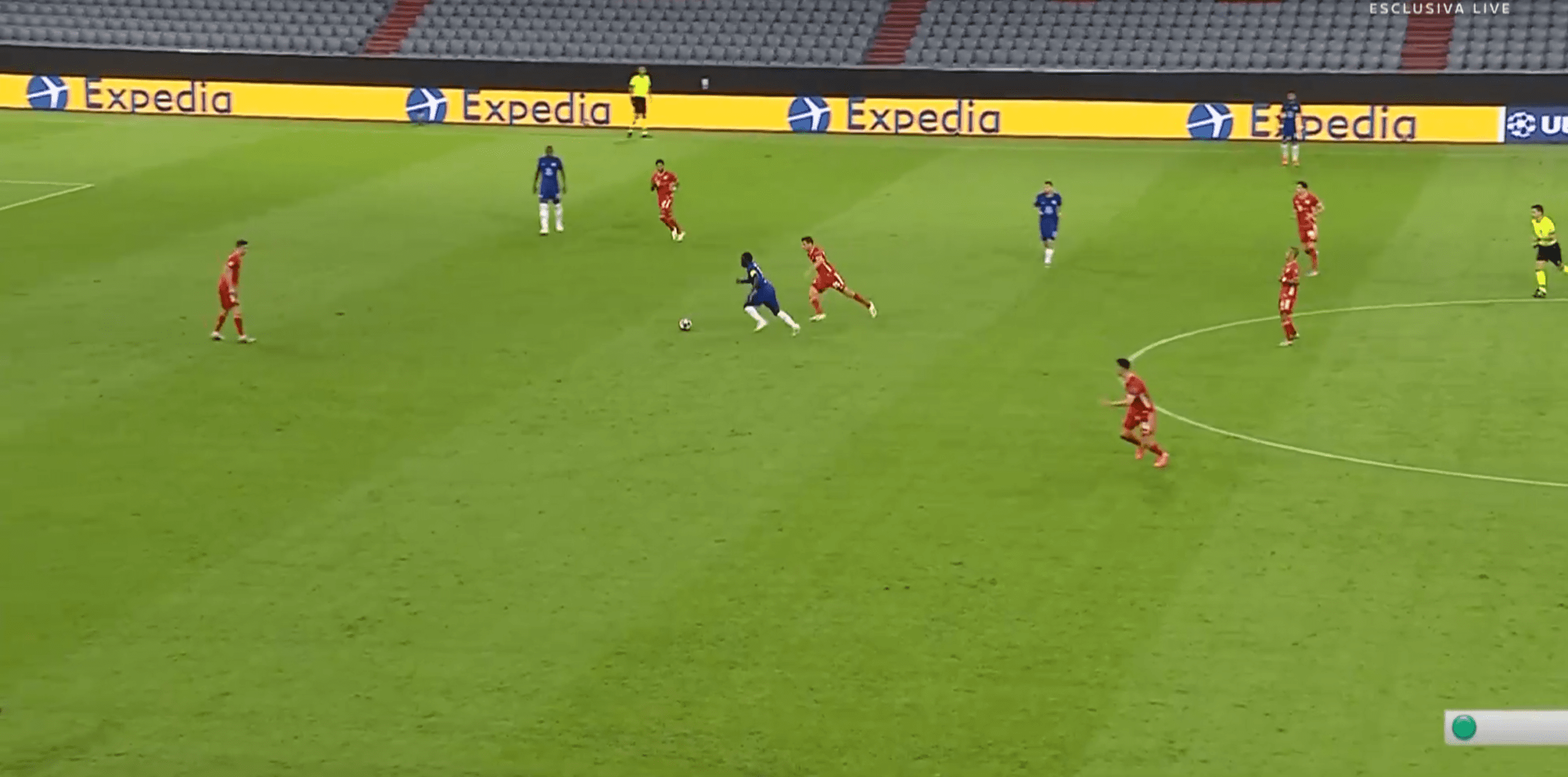
Bayern’s high line also makes them extremely vertically compact and difficult to play through at times, but of course then gives space behind to attack.In order to play through Bayern, you have to threaten them in behind and keep players upfield to pin their defence in shape, or they will squeeze any attack out with ease.
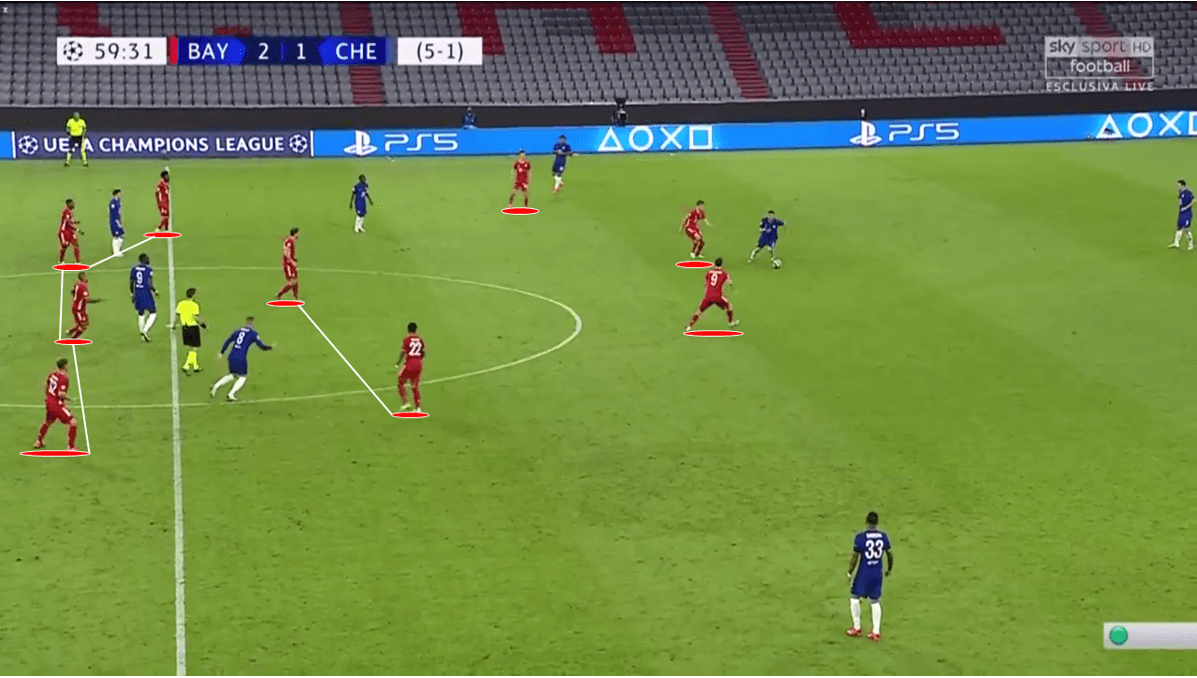
This next section will explore how Barcelona can build around this press, and also touch on the more advanced dynamics of Bayern’s press.
How can Barcelona exploit the press
The main ‘weakness’ in Bayern’s press, and the 4-4-2 press in general is the presence of only two central midfielders in the formation, and as a result, using intelligent movements and positioning, overloads can be created.
One team which best utilised these overloads in central midfield was Gladbach, who played a 4-2-3-1, with number ten Lars Stindl often dropping in behind or beside a Bayern central midfielder, helping to create a 3v2 overload in central midfield, or 2v1 on an individual Bayern central midfielder. Here Gladbach use a vertical overload on Bayern’s right-sided central midfielder, with a player behind and in front of him. This creates a decisional crisis for this midfielder, as if he commits deeper he concedes space higher and vice versa, and therefore this is difficult to defend against. Gladbach work the ball wide and then can play into the space behind the Bayern midfielder, and they have players occupying Bayern’s backline which prevent them from pushing out to close this space. A Gladbach player occupies the full-back while another occupies the centre back and threatens to get in behind, which pins Bayern in place.
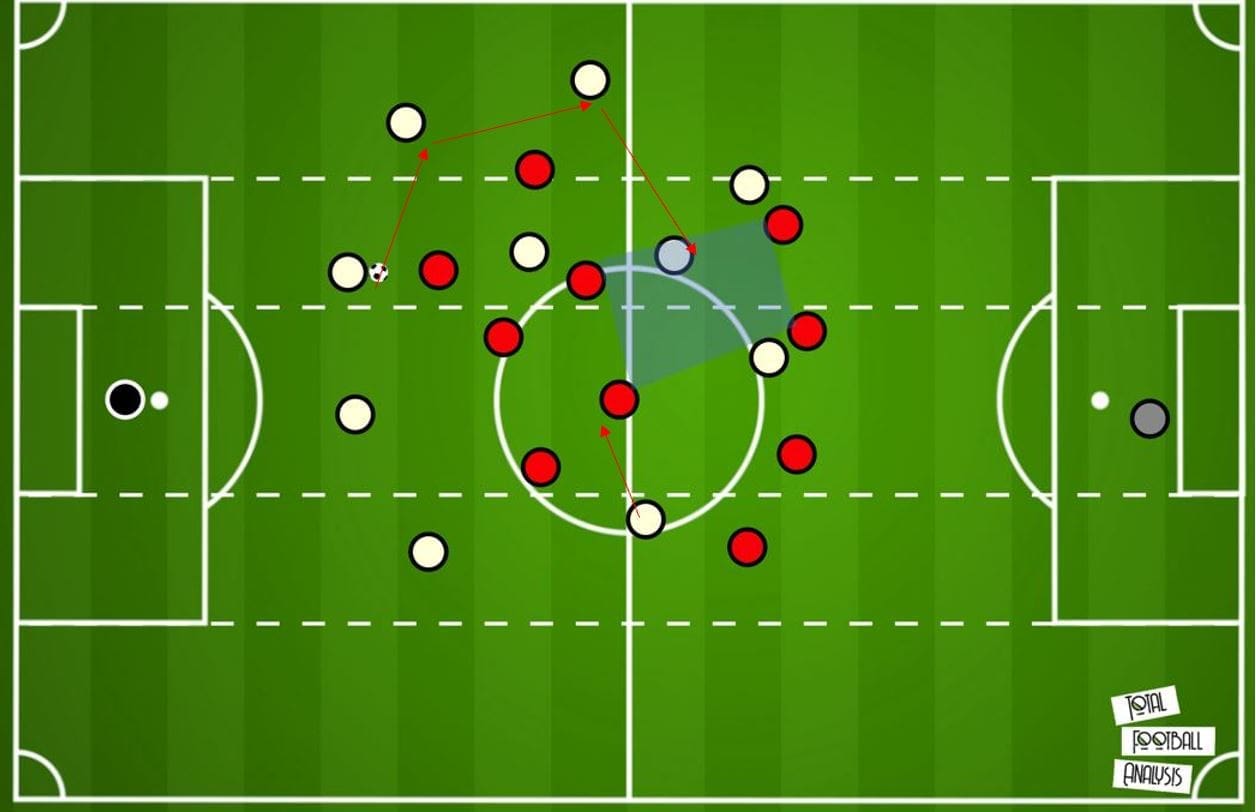
Borussia Dortmund also utilised these overloads well from wide areas, and we can see an example of this here. Julian Brandt drops deeper to show for a pass, while Mo Dahoud stays deeper as a pivot. Both players occupy Joshua Kimmich, and so it creates a decisional crisis for Kimmich as to who he presses. This allows for one free player to be created, and so Dortmund are able to progress the ball.
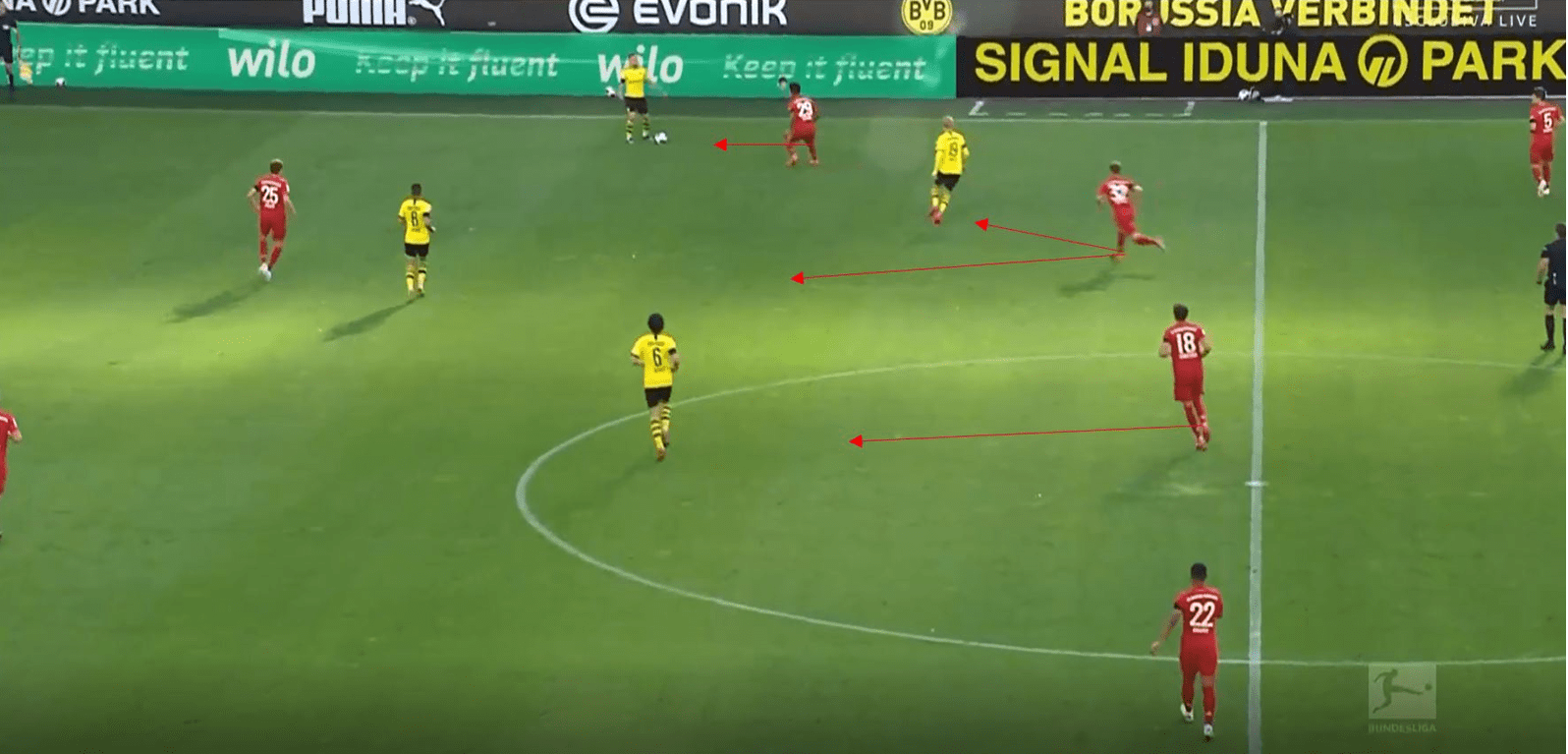
Bayer Leverkusen were also able to create the same overload at times, with here Leon Goretzka having two players either side of him. If Goretzka commits higher, he concedes the deeper space, while if he commits deeper he concedes the space in front. The other central midfielder is occupied at all times to prevent them from nullifying the overload, and so one player is always able to receive if done correctly.
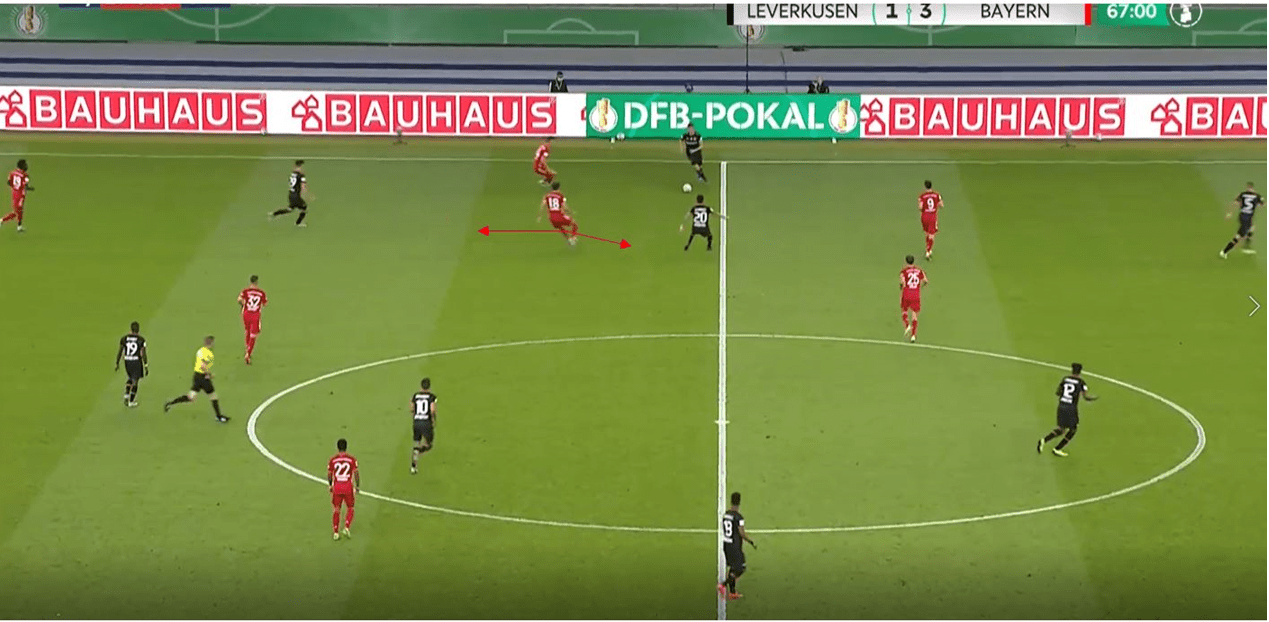
Here Bayern get a taste of their own medicine, with Gladbahc dropping to form a back three while maintaining a single pivot. Lars Stindl here remains behind the opposition midfield line on Kimmich’s side, while Florian Neuhaus becomes a single pivot. Kimmich’s midfield partner is occupied, and Kimmich may not actually realise Stindl is behind him. Either way, a 2v1 or 3v2 is being created when the pivot receives, and so when Kimmich moves slightly forward to press, Stindl is able to receive in the space behind Bayern’s midfield.
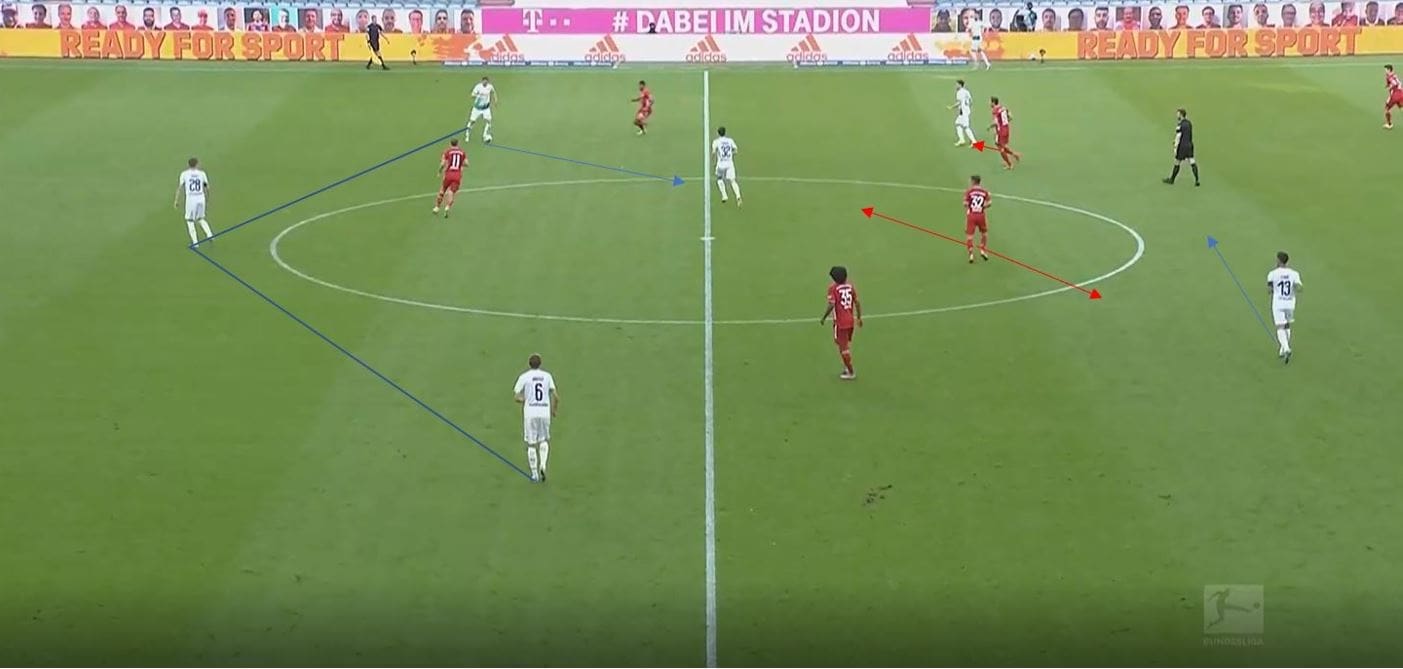
There are many different ways in which this overload can be created, and I have identified these scenes in most of my Bayern Munich analyses on the site.
How can Barcelona create overloads
Despite this weakness in the system, Bayern do a solid enough job of nullifying overloads when they can, and so it is up to Barcelona to create these situations and use them effectively. To assess how they might fare in creating these overloads, I watched footage of them against sides pressing in a 4-2-3-1/4-4-2, in order to compare the game dynamics to Bayern.
In order to compromise with their out of possession setup, I believe a 4-4-1-1 shape in possession would allow them the best shape to create overloads while maintaining defensive stability. We can see this shape placed against Bayern’s press below. In this situation, the Bayern central midfielders would press the two Barcelona central midfielders, while Barcelona’s number ten would have a freer role, similar to the role Lars Stindl played for Gladbach against Bayern, except in this game, it would be Lionel Messi. Messi would have the responsibility of creating those overloads in a variety of ways, and I will touch on his role in more detail shortly.
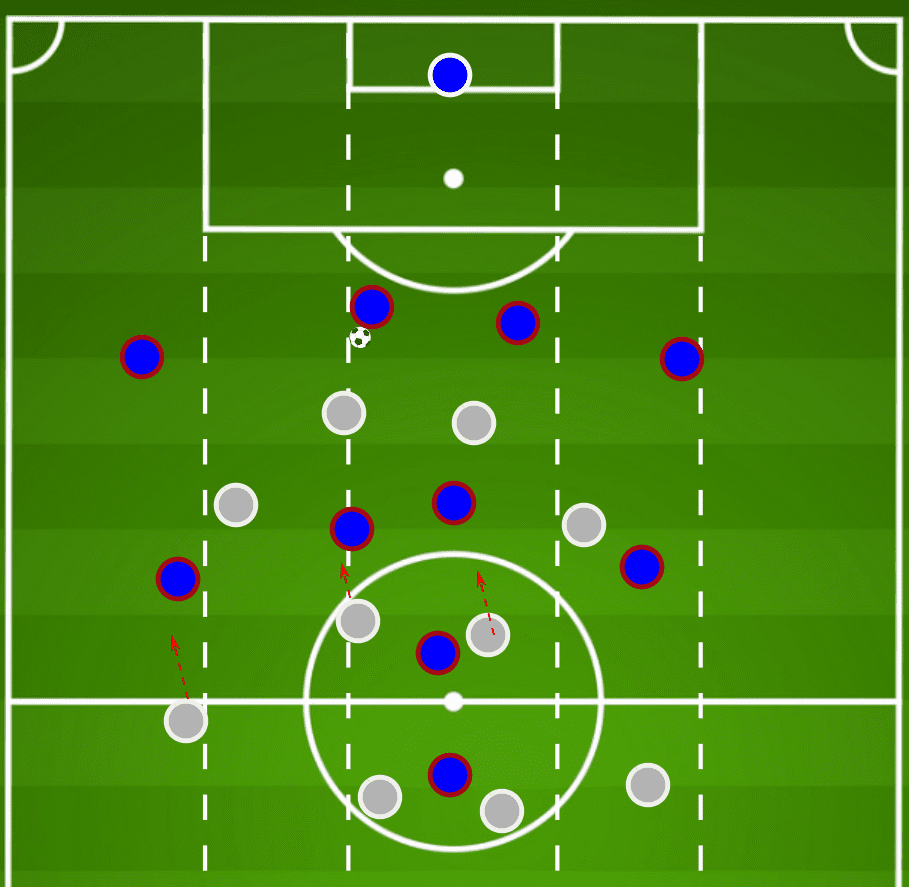
Although Barcelona have had success playing against the 4-4-2/4-2-3-1, both Eibar and Napoli both pressed fairly poorly compared to Bayern, and so on some of the occassions where they created overloads, these would not be possible against Bayern.
This situation here with Barcelona in their 4-3-1-2 shape gives a good idea of how overloads could be created in central midfield against a 4-4-2 using Messi’s skills. We see Napoli are in a 4-4-2 shape similar to Bayern’s with the same vertical compactness Bayern show. Rakitić drops as the central pivot between the two Napoli strikers, while the Napoli right central midfielder is occupied. As a result, you would expect the left central midfielder to press. If they do, Messi should come across to occupy the space between the two Napoli players and create a vertical overload, where the midfielder has two players in front and behind him. If he arrives into the space like this, he can pick out a defence splitting pass easily, or even dribble through a few players.
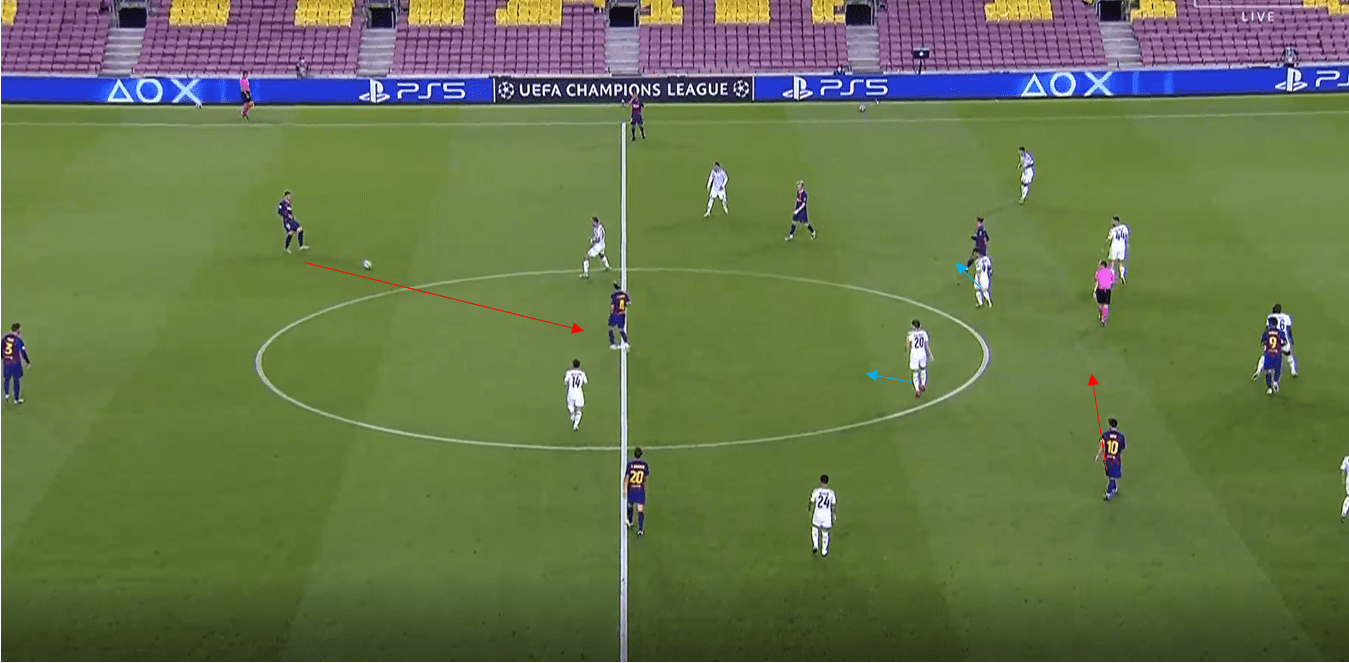
In this situation much deeper against Eibar, Rakitić again receives the ball as a single pivot, only this time Messi is in a position to create the overload. The left central midfielder is again occupied both ways, and can’t cover across quickly enough to cut the lane to Messi. As a result, Messi receives, and Barcelona go onto score. Messi’s ability to turn in this situation, protect the ball, and dribble past players in tiny areas make him a perfect candidate for this role.
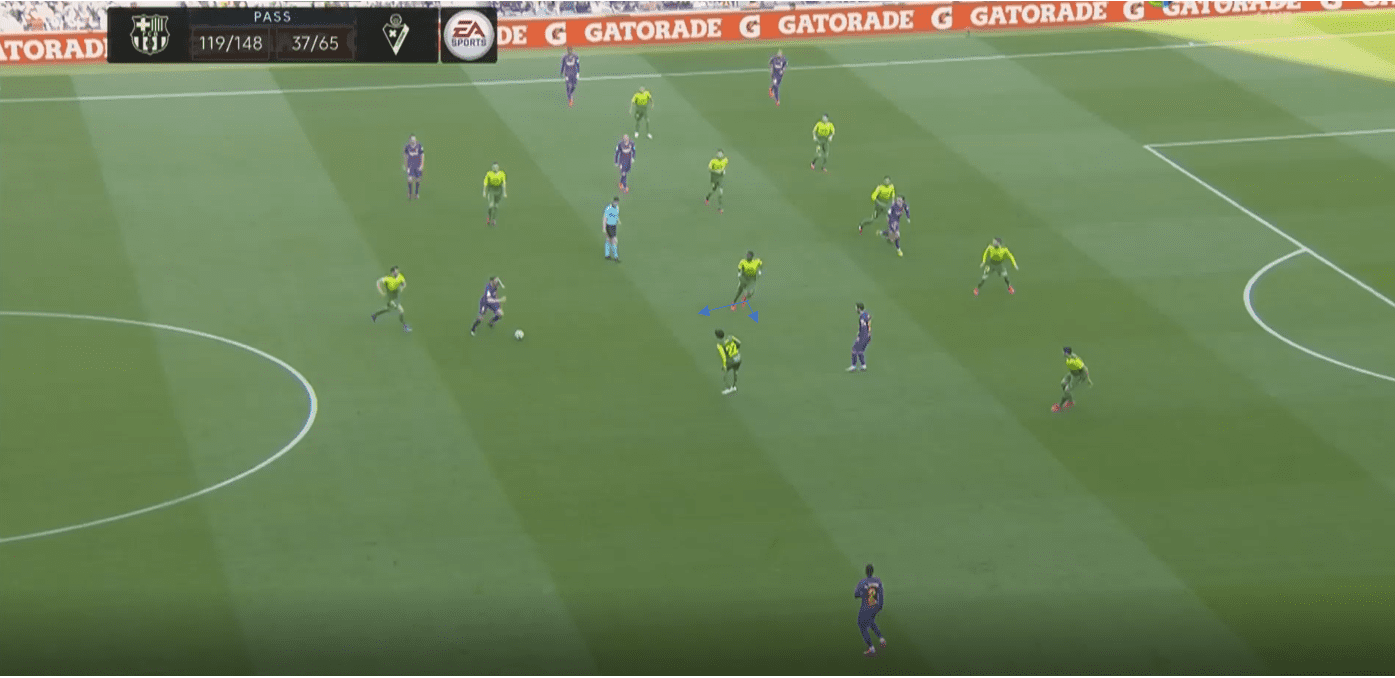
Here Messi is involved in a nice overload again, with Barcelona here in a 4-2-4 type formation, which can easily be replicated in a 4-4-1-1. We see the centre back is on the ball, and the right central midfielder offers a pass and is pressed by the Eibar midfielder. Higher up the field, striker Griezmann starts from deep and feints a run in behind, while Messi starts high and makes the opposite movement. Barcelona work the ball to the left central midfielder Busquets, who can then find Messi, who occupies the space in behind the pressing Eibar midfielders. These kinds of ideas are what is needed to break the Bayern press.
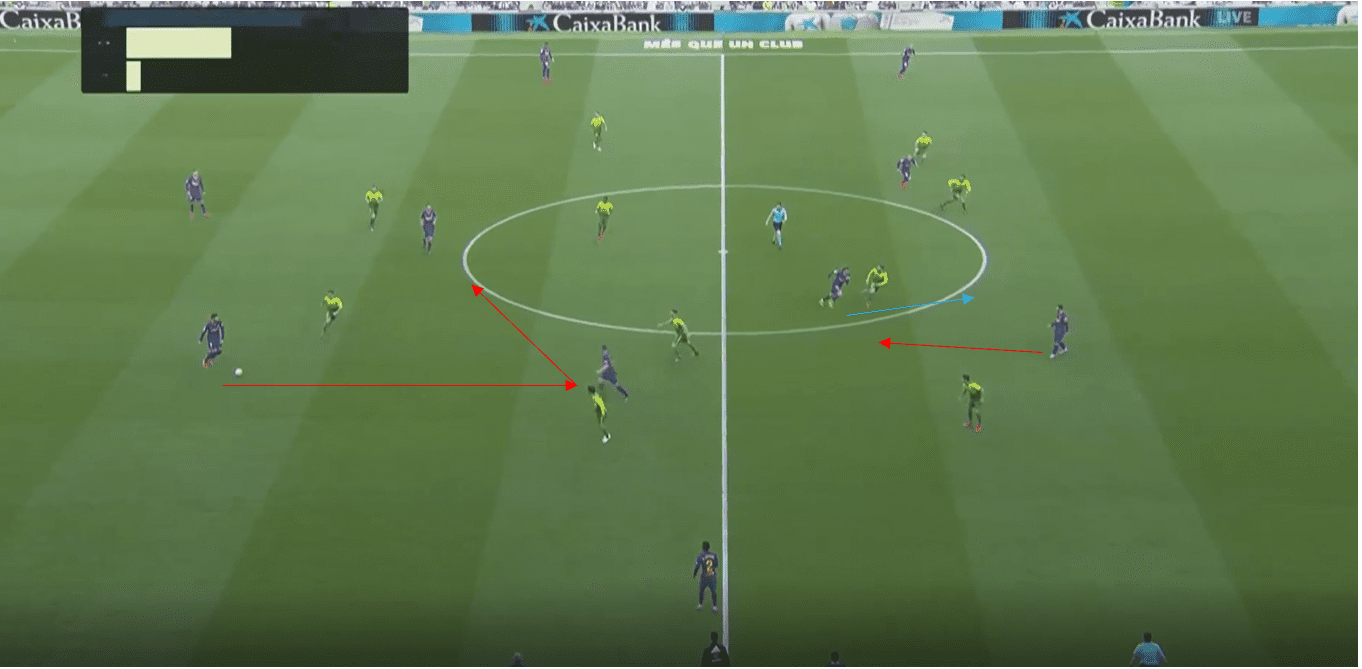
Here we see Barcelona build through Napoli again using an overload. Bayern generally press better than most of the teams Bayern have faced, both on an individual and collective level, and so it can be difficult to assess whether specific situations would work against Bayern, and so Barcelona really just need to find out in-game and adapt. We see Barcelona have dropped Sergi Roberto into a back three, while Rakitić comes across to receive deep again. The Napoli central midfielders have players to their sides and also a player behind them between the lines. The natural responses I would like are highlighted below, with a curved run made by the left centre midfielder while the far side pair squeeze across. The left central midfielder could also make a straight run, and get his left-sided midfielder to tuck in to cover Messi.
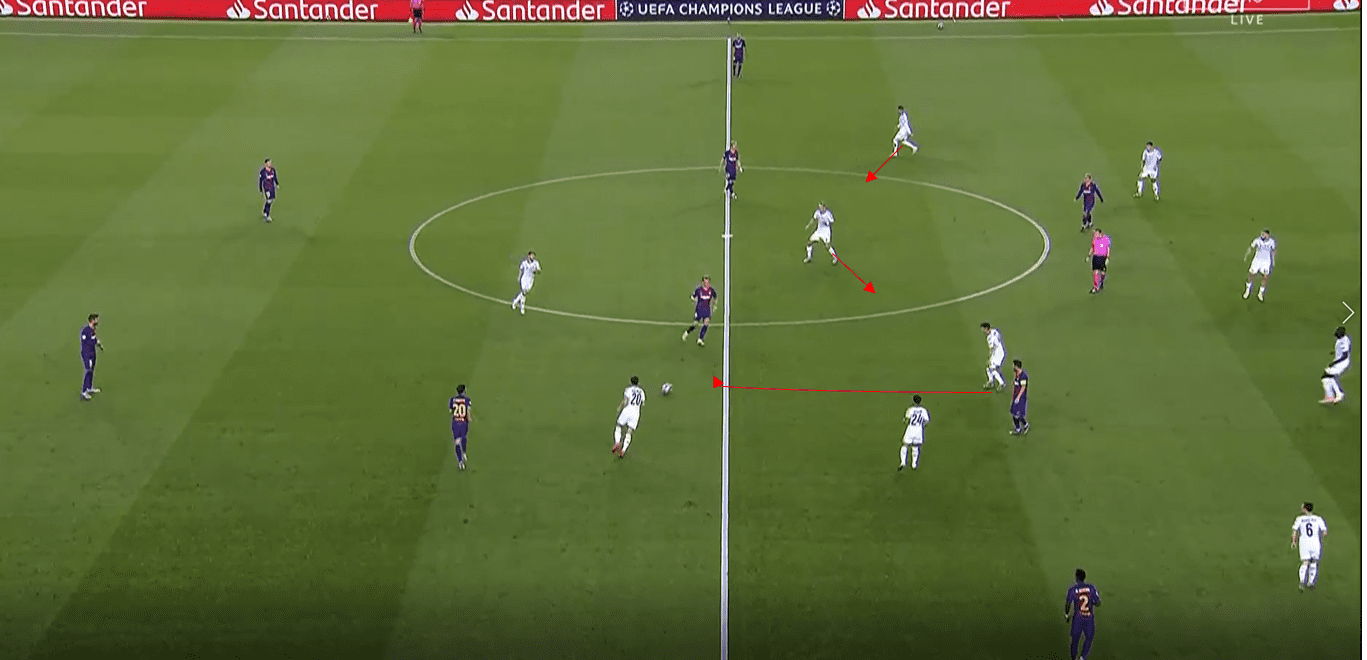
The curved run is chosen, but Napoli’s right central midfielder doesn’t tuck across, perhaps due to his attention being engaged by Frenkie De Jong beside him. As a result, Griezmann is able to receive between the lines. If Bayern were in this situation, and if they hadn’t closed that space in midfield, I would expect them to get more vertically compact and for the centre backs to then push onto Griezmann, but again Napoli don’t react as quickly as that. Luis Suárez hinders this attack massively, as no height is provided to the attack due to his poor offside positioning. As a result, Napoli here can push up freely and squeeze the attack. Suárez has to ensure he remains in a position which pins the Bayern central defenders.
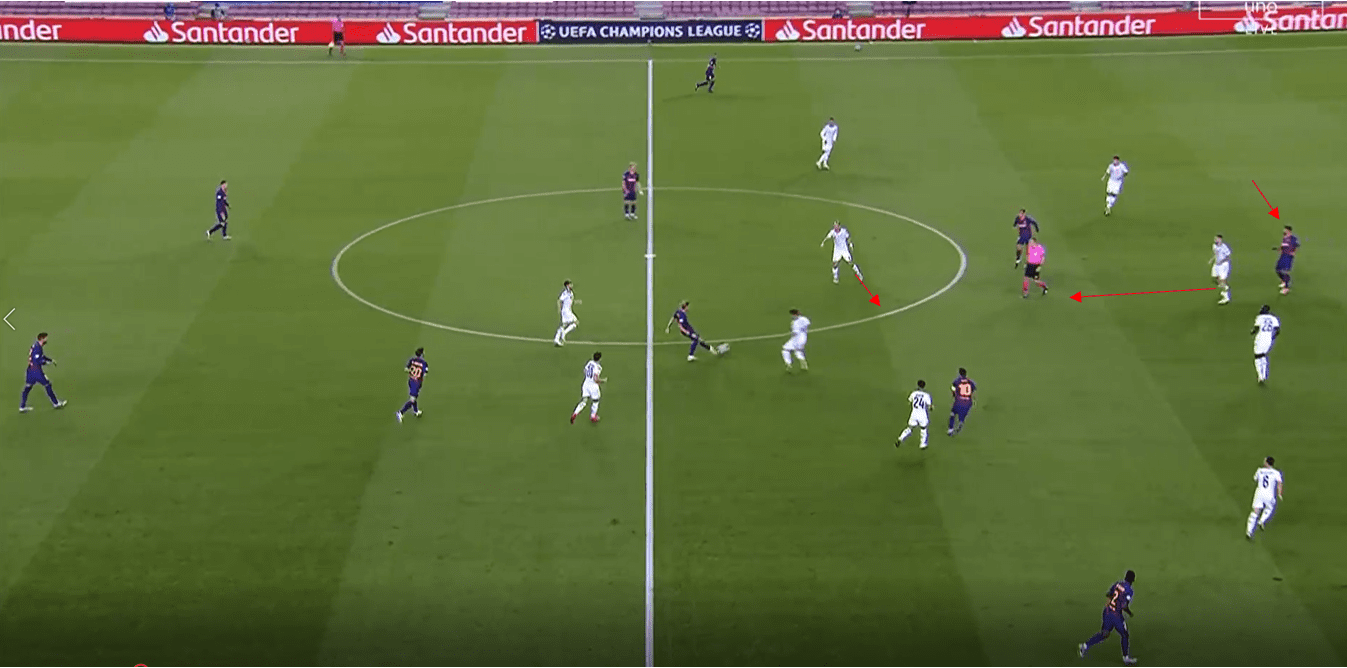
One key aspect that was often missing from Barcelona’s build-up against a 4-2-3-1/4-4-2 was width, and specifically the role of pinning the opposition full-back in place. We can see this in a few examples below. This kind of situation may be one Barcelona find themselves in if Bayern opt to sit deeper at times and allow Müller to press the pivot as he did mostly against Chelsea. Barcelona in these situations have to ensure they maintain the basic principles of positional play, and I believe that a 4-4-1-1 would allow them to do that in this situation.
We see here the half-space is occupied while the full-back is wide and has the ball. The problem with this structure is fairly simple, in that no real width is provided to help the half-space, as the Napoli full-back is free to press the half-space easily. A key idea which Barcelona need to use is to pin the full-backs, as this will give space for the likes of Messi to operate in the half-space without being pressed easily.
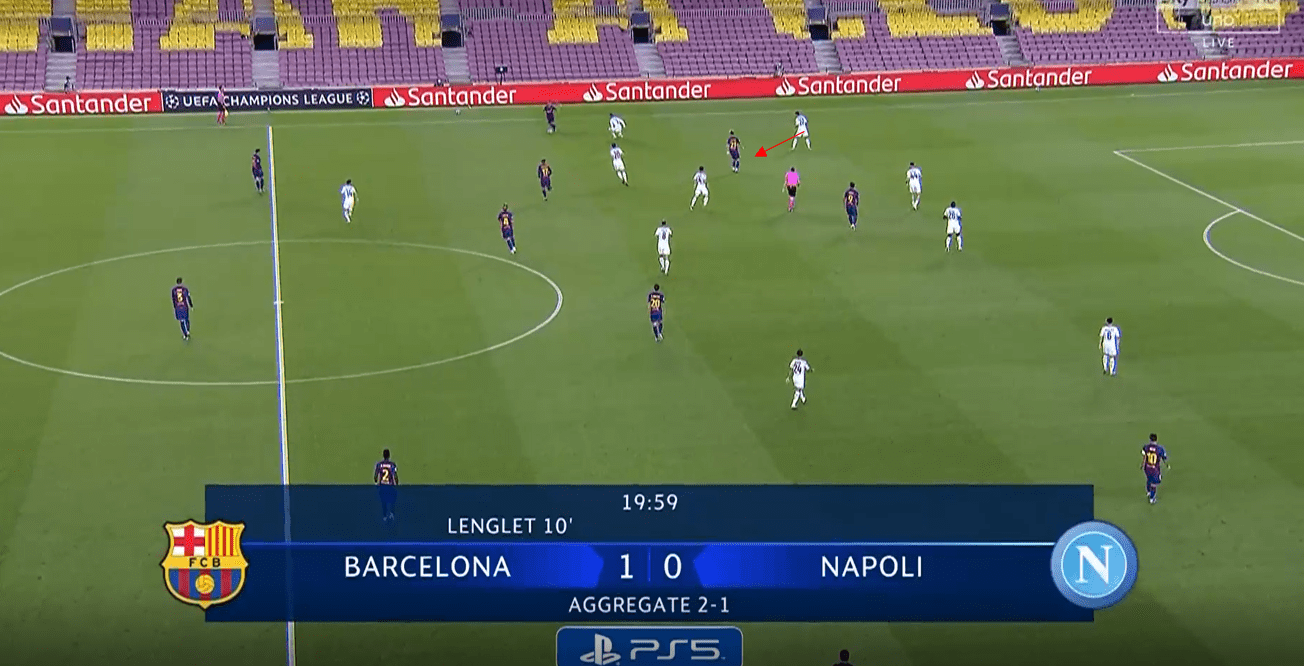
If we imagine this scenario slightly deeper and involving Barcelona in a 4-4-1-1, we see how having that winger present allows for the full-back to be pinned more easily, and how it may also allow for the creation of overloads around the central midfielders. The use of winger such as Ansu Fati also helps to pin Bayern due to his pace and threat in behind, which is something Gladbach used really well to their advantage.
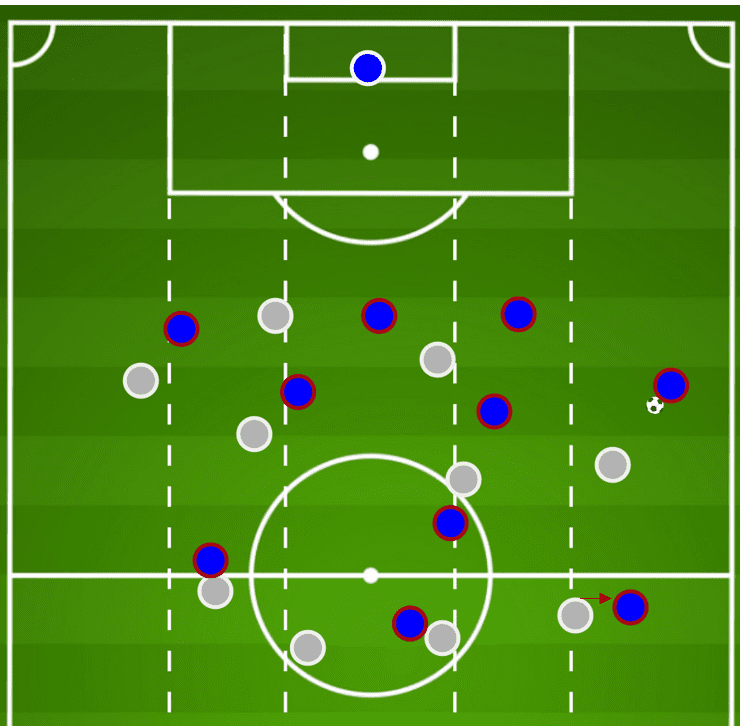
This image below also showcases the need to pin the wing-back, as well as the role of the central midfielder. With the full-back on the ball, the Eibar full-back should be occupied and dragged wide, in order to open up the half-space. Before this, the near side central midfielder should drop into the space afforded to create a vertical overload on the Eibar right central midfielder. A lone striker should then provide the height in order to penetrate in behind and offer a focal point.
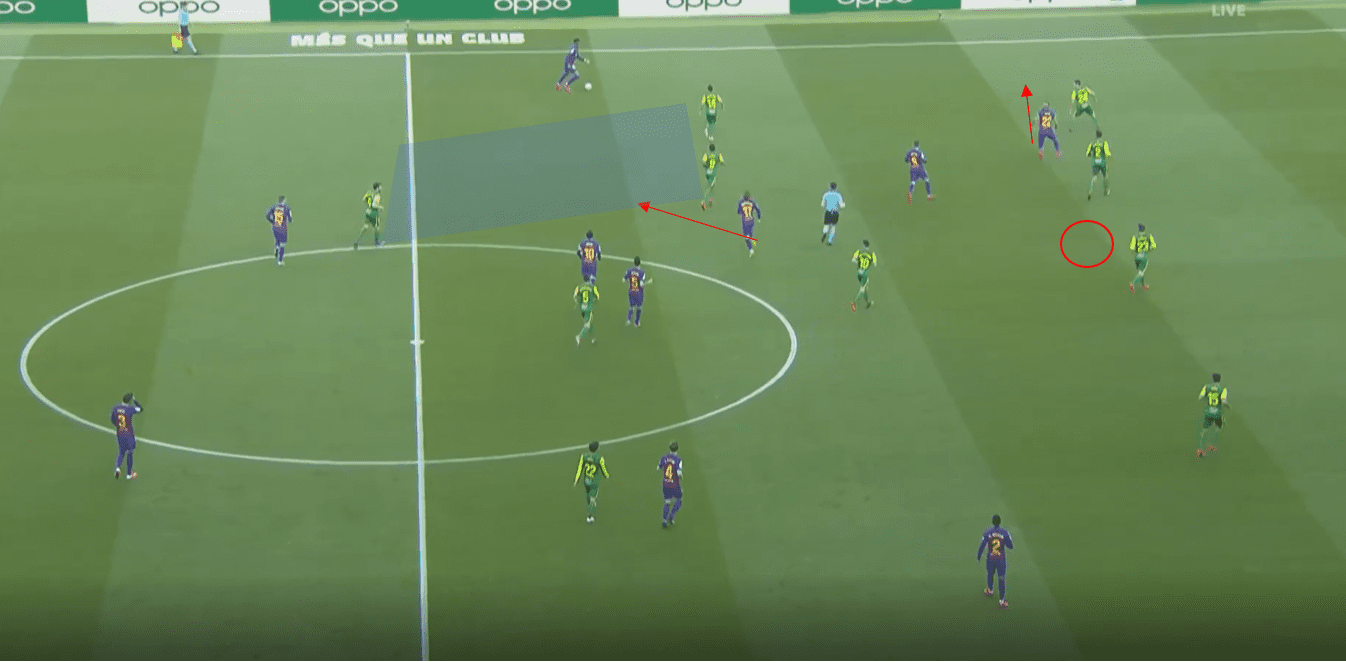
This example from Gladbach against Bayern is a good example of a structure used. The Bayern central midfielders are occupied with the Gladbach central midfielders, while a 2v1 is created around the Bayern full-back. This pins the full-back wide and opens up space for that roaming ten Lars Stindl to receive. Bayern’s central defenders are nowhere to be seen, as Gladbach offered a threat in behind.

Messi’s gravity and Bayern’s adjustments
Bayern do a good job of nullifying overloads at times, and Joshua Kimmich is particularly adept at pressing while overloaded and managing the situation accordingly, and so it is no easy feat to just create an overload and play through, meaning the space occupation of Bayern will have to be excellent to get the better of the press. One useful weapon in their arsenal is Lionel Messi, and more specifically his gravity.
Gravity is defined in basketball by Kevin Felton of ESPN as: “the tendency of defenders to be pulled to certain parts of the floor” with every offensive player said to possess their own gravity. Lionel Messi possesses high gravity, so in other words, opposition players view him as a priority when defending. In overloads in central midfield, this is important, as Bayern central midfielders often have a split-second decision to choose who to cover. If Messi is one of those options, it is possible some Bayern players may pay extra attention to him.
In a way then what I am suggesting is using Messi as a decoy at times when creating overloads. Not all the time of course, as then you remove the World’s best player from build-up, but varying the build-up to ensure everything doesn’t go through Messi will be important.
Below we can see an example of how Messi could be used as a decoy. Messi drops in front of the central midfielder in the half-space and offers himself for a pass. The Barcelona central midfielder also offers himself, creating a 2v1 decisional problem for the Bayern midfielder. With Messi visible and directly in front, the Bayern player may be drawn towards limiting Messi, and so the ball can be played to the far player, and then a diagonal pass can be made through to the winger.
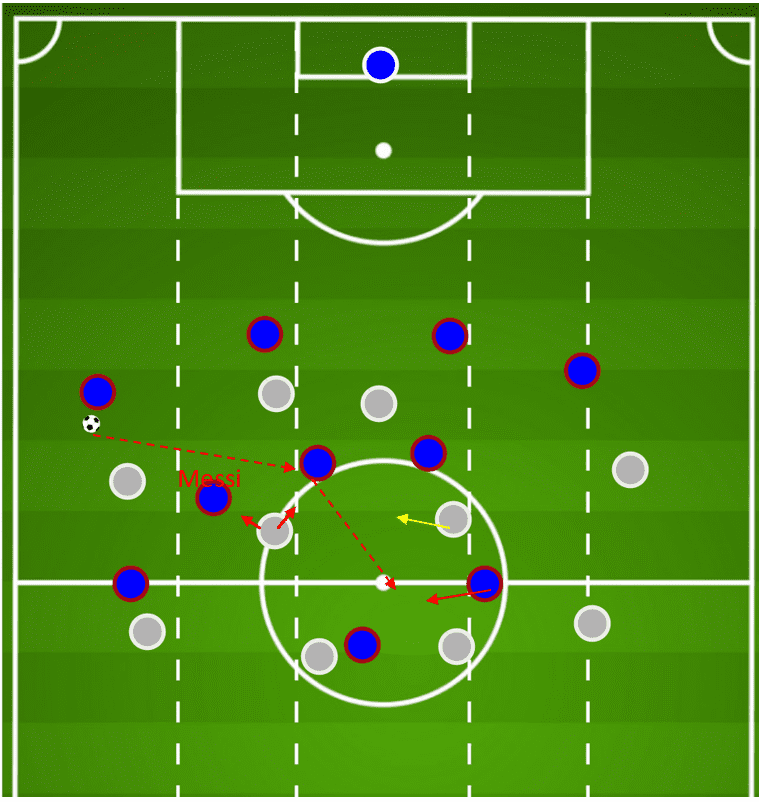
The key adjustment Bayern could make in the game would be for Thomas Müller to become responsible for pressing the nearest pivot. This would give more time to Barcelona’s back line, but would go some way to limiting these overloads being created. This isn’t a new structure to Bayern, as it simply represents the 4-1-4-1 I mentioned earlier, which is used situationally. It was used fairly often against Dortmund, with Joshua Kimmich often sitting deeper and staying with Julian Brandt, while Müller dropped in to press one of the opposition pivots. They also used this shape a lot against Chelsea in the second leg as mentioned. In these situations, in becomes important that Barcelona recycle possession often with the centre backs, as this will give them the opportunity to drive forward with the ball and engage the press.
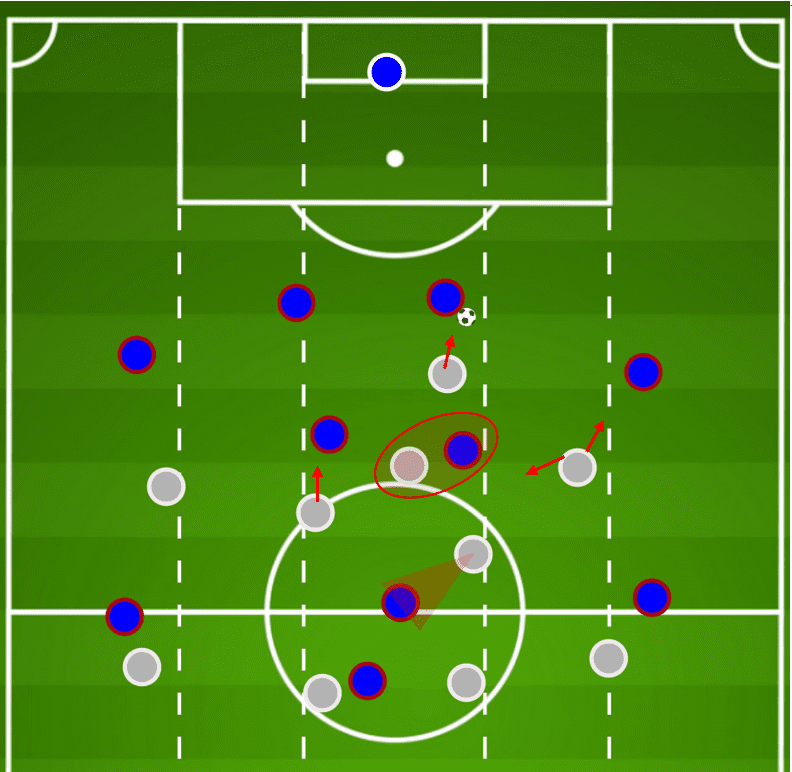
To solve situations like this and others, Barcelona will have to vary their build-up play too. One such example can be seen below, with a central midfielder dropping into the back line to form a three. This will engage Bayern to press in the way highlighted below, which manipulates Bayern’s second line and helps to therefore open up longer passes through the area. Players may have to drop deeper here to receive, but superiority can still be gained.
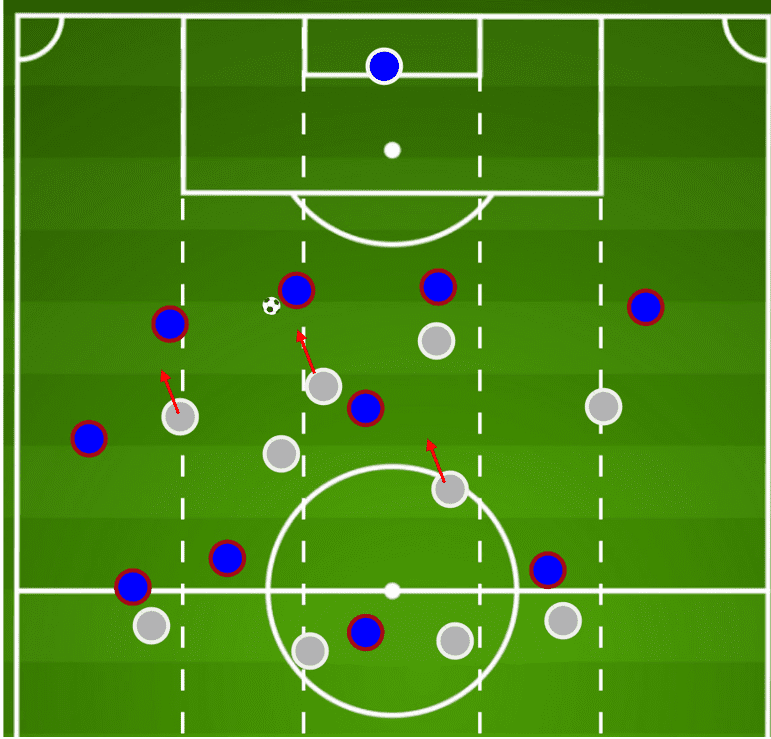
Conclusion
In conclusion, I think Bayern come into the game having earned the title of favourites, with their pressing system and positional play making them very difficult to beat. Barcelona face an uphill task, but if they can play their game in right areas and work efficiently out of possession, their quality in attack could carry them through. The game promises to be an interesting tactical battle between Europe’s elite, and it will no doubt be interesting to see if Barcelona still have what it takes to compete with sides of Bayern’s ilk.





Comments